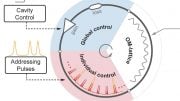
Recent research shows that the visual spectacle of milk swirling in coffee does not affect the molecular structure of milk proteins. This study, using advanced 2D infrared spectroscopy, confirms that milk proteins retain their structure and function in the presence of caffeine and other coffee-derived compounds, maintaining the taste and mouthfeel of coffee beverages.
Research indicates that adding milk to coffee does not alter the molecular structure of milk proteins, ensuring the consistency of taste and texture in coffee drinks.
The swirl of milk and espresso — a small storm in your mug — doesn’t impact the dynamics of the milk proteins, according to research published in ACS Food Science & Technology. Researchers conducted a detailed molecular analysis to explore how milk proteins and caffeine molecules behave in water and coffee. They discovered that the molecular structures of the milk proteins are preserved, ensuring that they maintain their natural texture and flavor in your daily coffee.
Pouring milk into coffee causes the proteins to interact (e.g., combine or repel) with compounds extracted from the roasted, ground coffee beans, and that could change the proteins’ mouthfeel and the way they are digested. Milk proteins could also potentially affect the absorption, or bioavailability, of caffeine by the human body. To shed light on these mysteries, Tobias Weidner and Fani Madzharova used 2D infrared spectroscopy to investigate milk proteins’ molecular structures and dynamics when in a coffee beverage. They assessed increasingly complex mixtures of a store-bought whole fat (3.5%) milk, water solutions with milk and caffeine, and then a handmade cappuccino.
They found that the folding of milk proteins was unaltered by the presence of caffeine in these beverages, even in the cappuccino, which contained components extracted from the coffee grounds, such as chlorogenic acid. Additionally, while previous studies have reported that caffeine slows the molecular movement of water, this study didn’t show substantial effects from caffeine on the mobility or dynamics of milk proteins. These experimental results provide a useful molecular picture about some components that affect the texture, flavor and nutritional properties of coffee beverages with milk ingredients, which the researchers say could be applied toward engineering future drinks.
Reference: “Structure and Dynamics of Milk Proteins Interacting with Caffeine and Espresso Determined by Two-Dimensional Infrared Spectroscopy” by Fani Madzharova and Tobias Weidner, 15 May 2024, ACS Food Science & Technology.
DOI: 10.1021/acsfoodscitech.4c00070
The authors acknowledge funding from the Novo Nordisk Foundation, the Danish National Research Foundation through the Center of Excellence for Chemistry of Clouds, and the European Union’s Horizon 2020 Research and Innovation Programme under the Marie Skłodowska−Curie Grant.









I’ve always thought that espresso does not include milk.